If there's one thing we've learned over the last half-decade, it's that companies obsess over building their tech stack and picking the right analytics and growth tools. Should we use Amplitude or Mixpanel? Should we use Redshift or BigQuery? All tool categories will have hundreds of players whose feature sets will allow you to accomplish 95% of your use cases with ease.
We've now seen 15,000+ stack evolutions over 6+ years and we've learned one thing. It's not about picking the perfect tool. It's ALL about being in a position to quickly adapt your stack to changing business needs and the ever-changing martech ecosystem.
Over the next few months, we’re bringing you a series of real-life stories from those who have seen their stacks evolve in extraordinary ways. You’ll get a behind the scenes look into the growth of companies like Datadog, Pagerduty, and Gusto, as they share the how and why behind some of their key technology decisions.
This week, we talked to Frame.io’s VP of Growth & Analytics, Kyle Gesuelli. Founded in New York City in 2015, the video collaboration software company has grown to 120,000 monthly self-service and enterprise users. Their stack has seen similar growth. Since joining in 2017, Kyle has scaled its tech stack from a handful of tools to well over 100.
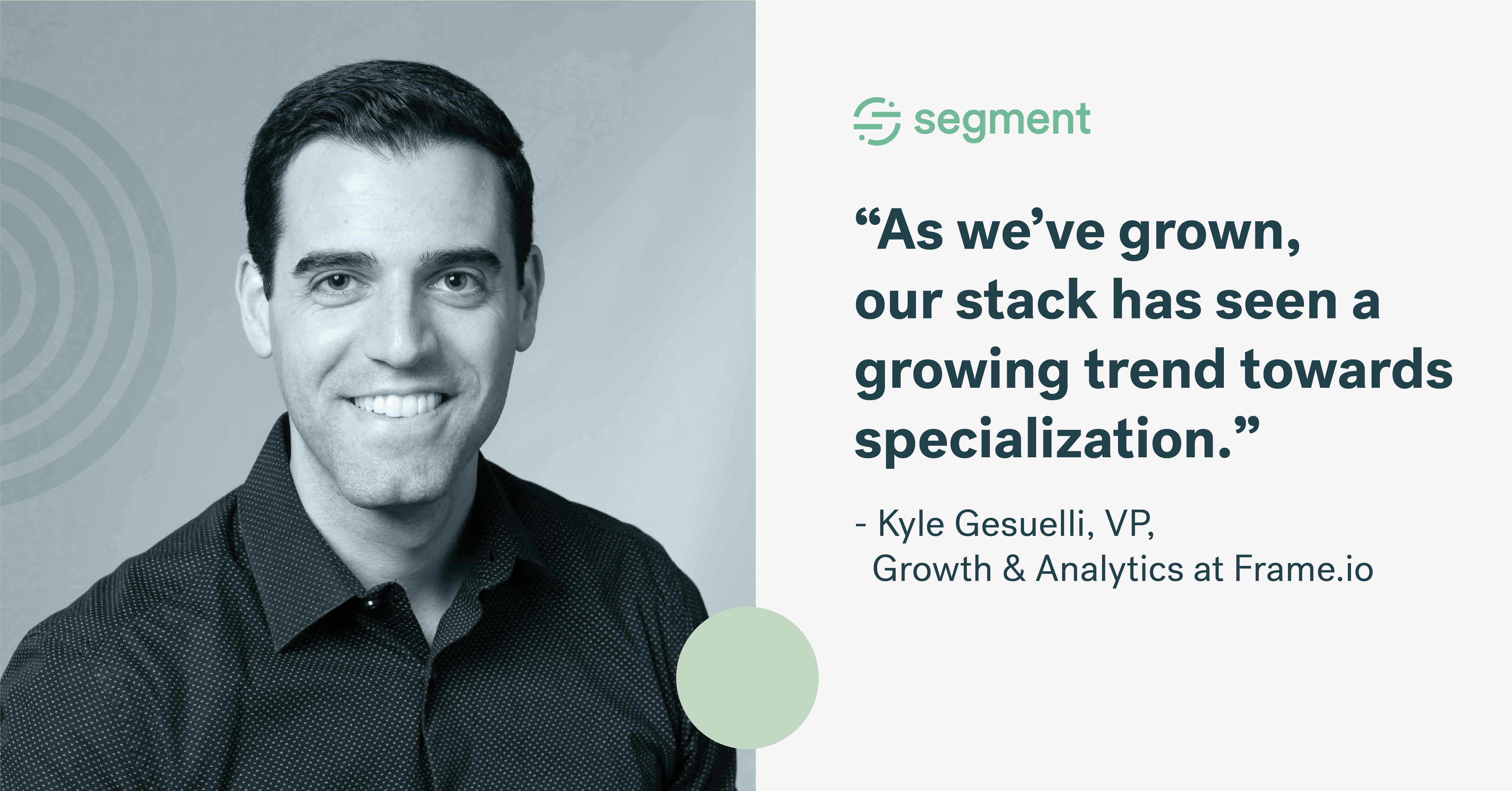
Fresh off their Series C announcement, Kyle sat down with us for a wide-ranging chat on:
-
The inflection points in their business that drives the adoption of new software
-
How he keeps so many different tools in sync
-
Why focused, point solutions beat all in one software
-
What he looks for in new technology
Dive into the interview below.
How Frame’s stack evolved
Geoffrey: Kyle! Thanks for joining us. When you arrived at Frame, how did you determine the health of your tech stack?
Kyle: I arrived at Frame in 2017, when we were about 17 people. Back then, there was no one on the marketing team. There was no one on the data team. It was just a few engineers, designers, and customer support.
As a result, our tech stack was pretty simple. We had probably 300,000 registered users and 30,000 monthly active users, but really, Mixpanel, Amplitude, and Intercom and a few other tools were all we needed.
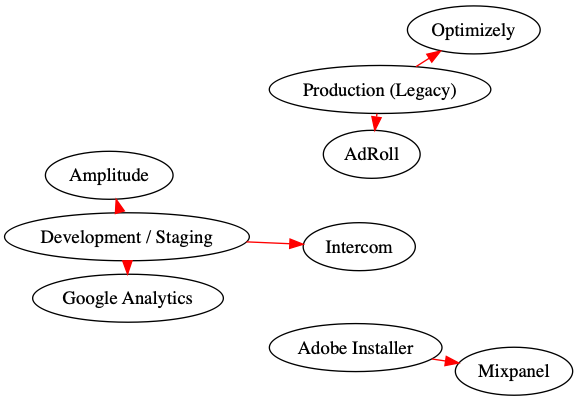
Frame.io’s stack in 2017
Geoffrey: What was the first change you made, and why?
Kyle: When you come in as the first growth hire, your ability to build new experiences is pretty limited until you hire a team. You can only focus on the areas that you can control, areas like communications, both in the product, outside of the product, whether that be email, retargeting, advertising, that sort of thing. It’s more about bolstering existing areas as opposed to diving into new ones.
Firstly, someone gave us the smart idea to install Segment. I think it’s probably because we share Accel as an investor! We started pretty simple; it was implemented client-side on a few core events. At that stage, we certainly weren’t tracking everything across Frame.io.
The second thing I did was help implement Autopilot for more robust journeying capabilities. Our previous tool, Intercom, was great for customer support and in-app messaging, but we found it less useful for communicating things like product launches. I wanted to be able to create richer email content that aligned with our brand, which is very visual and design-heavy, that I couldn't do in Intercom.
I also added Clearbit Enrichment to get a better sense of who our customers were, what their job titles were, etc. Then I connected all of the ad platforms – Facebook, Twitter, LinkedIn – so that we could use the key events we were logging in Segment as conversion values. This would tell the ad platforms that customers in these campaigns were doing X, Y, and Z and go find more customers who would exhibit the same behaviors.
Geoffrey: What have been the most significant changes in your stack to date?
Kyle: I think as we’ve grown, we’ve seen a growing trend towards specialization, which has affected the makeup of our tech stack. As we’ve grown, we require tools that go deeper than the ones we already have, which then drives the adoption of new tools.
For example, we loved Intercom for support and documentation but wanted to connect our sales team with live visitors so adopted Drift. We liked Drift, but we needed a way to enrich anonymous IP addresses, so we adopted Clearbit Reveal.
Yes, there’s probably one product that could do all of this, but not in the depth or sophistication that we need for a business of our size.
Where Segment is really valuable is that it helps us discover and connect with all of these great point solutions.
For example, when we needed a tool to capture net promoter score, our first step was to look in the Segment catalog, and see what tools are available there. What's going to be the easiest thing to quickly turn on in one click. It was in the catalog that we found Promoter.io, which wasn't a standard source in the Segment catalog, but that you could set up easily via an HTTP source.
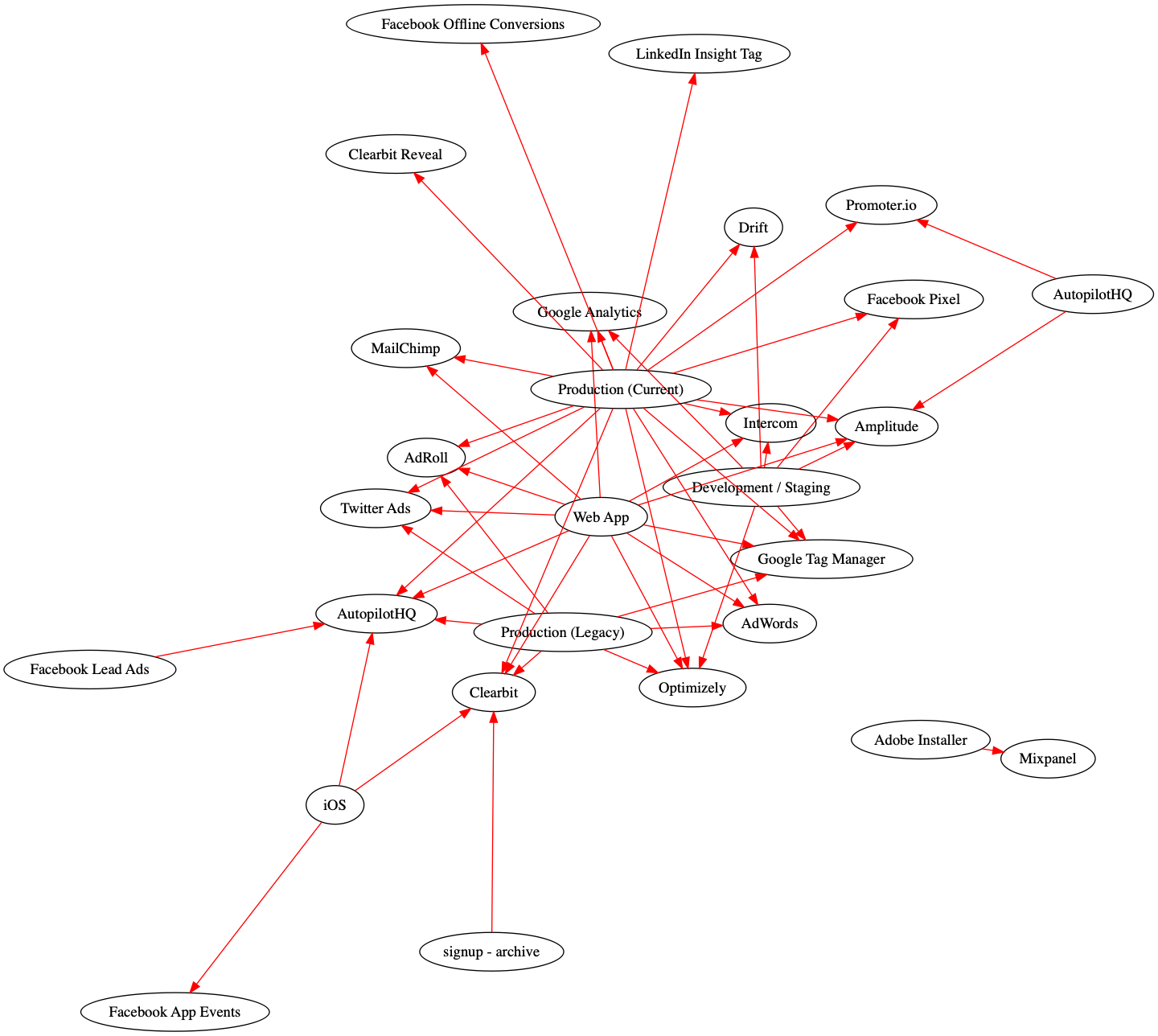
Frame.io’s stack in 2018
Geoffrey: With so many different tools and so many different data sources, does it become hard to keep track of all of these tools at once?
Kyle: When we bought Segment Personas, that changed things significantly for us. One of the issues of having Segment connected to a lot of marketing tools, in particular, CRMs, is that event properties get sent as user traits.
This becomes hard when you’re tracking as much data as we are. I'd guess we're in the top 1% of Segment customers in terms of just how much data we're logging. It’s probably unusual for a company of our size, but we log everything, even every button click. We have about 700 different events that we log, each of which has its own set of unique properties.
Personas enabled us to craft traits about our users and then send those cleaned traits out to all the tools so that they're all in sync. That got ratcheted up even further when Personas released SQL traits. That was the holy grail for me. I can now crunch statistics or traits about users from not only the data that Segment collects on them but from our own database of transactional data.
So I write queries in Segment, in Personas, I connect Segment data and transactional data to get these traits that I want. And then I federate those traits out to all of the tools that need them.
So if I want to know if a user is associated with an enterprise plan and Frame.io, I can craft that trait on my transactional data, understanding all the relationships a user has with multiple accounts. It will then give a true/ false answer as to whether they are associated with an enterprise account.
Then I can send that data out to Intercom and Salesforce and Autopilot and Facebook, and I’ll be able to tailor communications and other experiences accordingly.
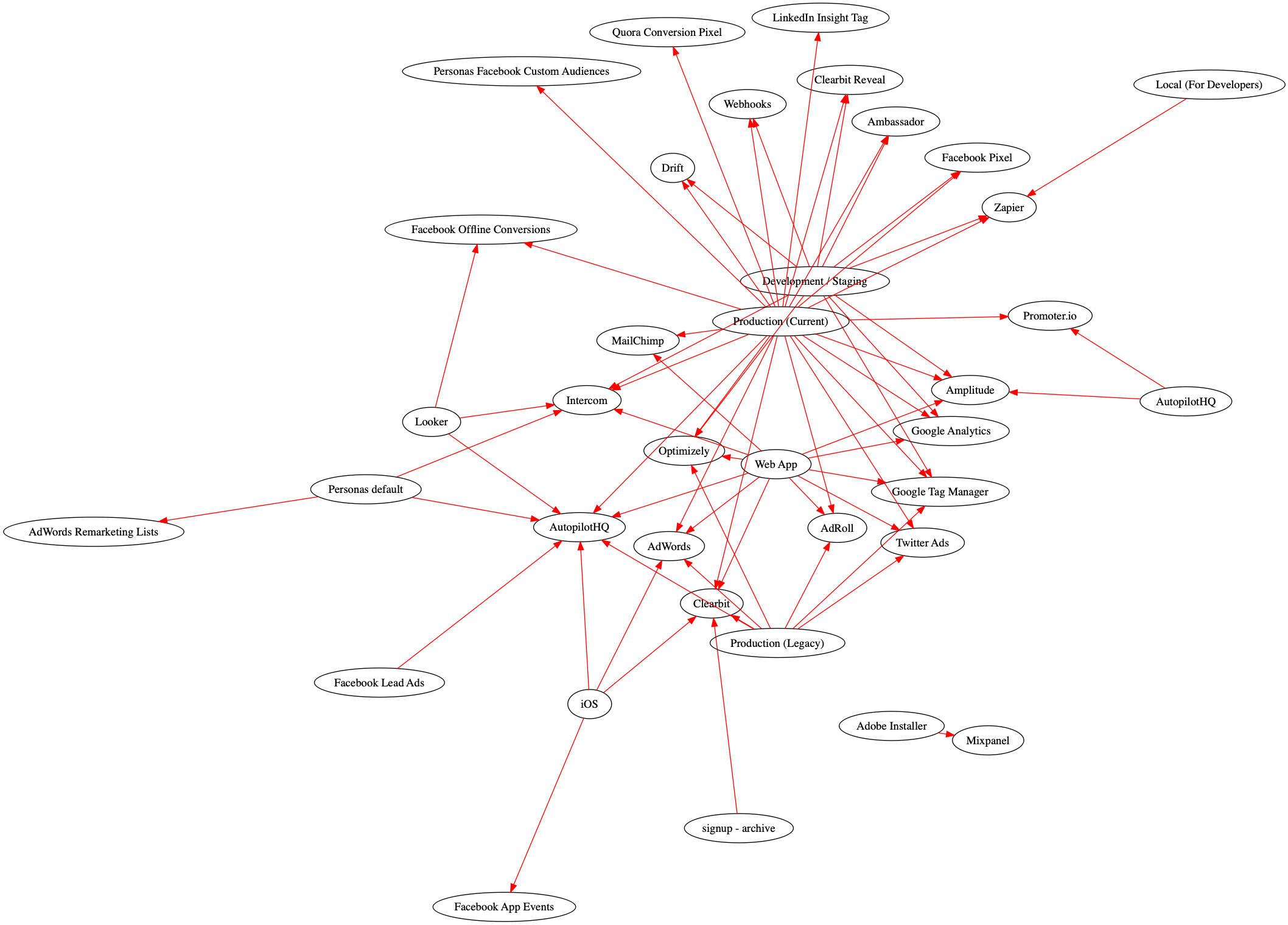
Frame.io’s stack in 2019
Geoffrey: I feel like businesses are often sucked in by the latest and greatest marketing technology, and will just rip and replace older tools as opposed to iterating on what they currently have. How do you approach new technology at Frame?
Kyle: I don't think we've ripped out anything just yet. I think we're coming to that point today where our scale begets a change. Maybe you're getting too big for a certain system or that company the company might have changed its pricing, and it just doesn’t make sense to use them moving forward.
But in general, our technology has all been additive, to supplement our existing technology with new functionality. For example, even though we use Intercom, we also brought Appcues in a few months ago. Appcues can do NPS, product tours, and in-app messaging. I’d probably spend twice as much as I need to on all of that if I tried to consolidate all of that into one tool. I think we’ll end up gradually move towards consolidation, but we’re not necessarily at that scale yet.
The endless debate - all-in-one consolidation vs. best of breed
Geoffrey: Most marketing technology platforms fall into one of two categories. They’re either point solutions that specialize in solving a deep, defined subset of challenges. Or suites that offer multiple tools and and solve the “tool overload” challenge facing many marketing organizations. Do you prefer best of breed solutions or consolidation?
Kyle: It is a case by case basis. I would love to consolidate, but sometimes these all in one tools will get you 90% of the way there, but then fail at that last 10%. For example, Intercom has certain features of Drift, and Drift, has certain features of Intercom, but they don't necessarily do 100% of what the other one does. That’s why we have two, and we will continue to add more and more as time comes about.
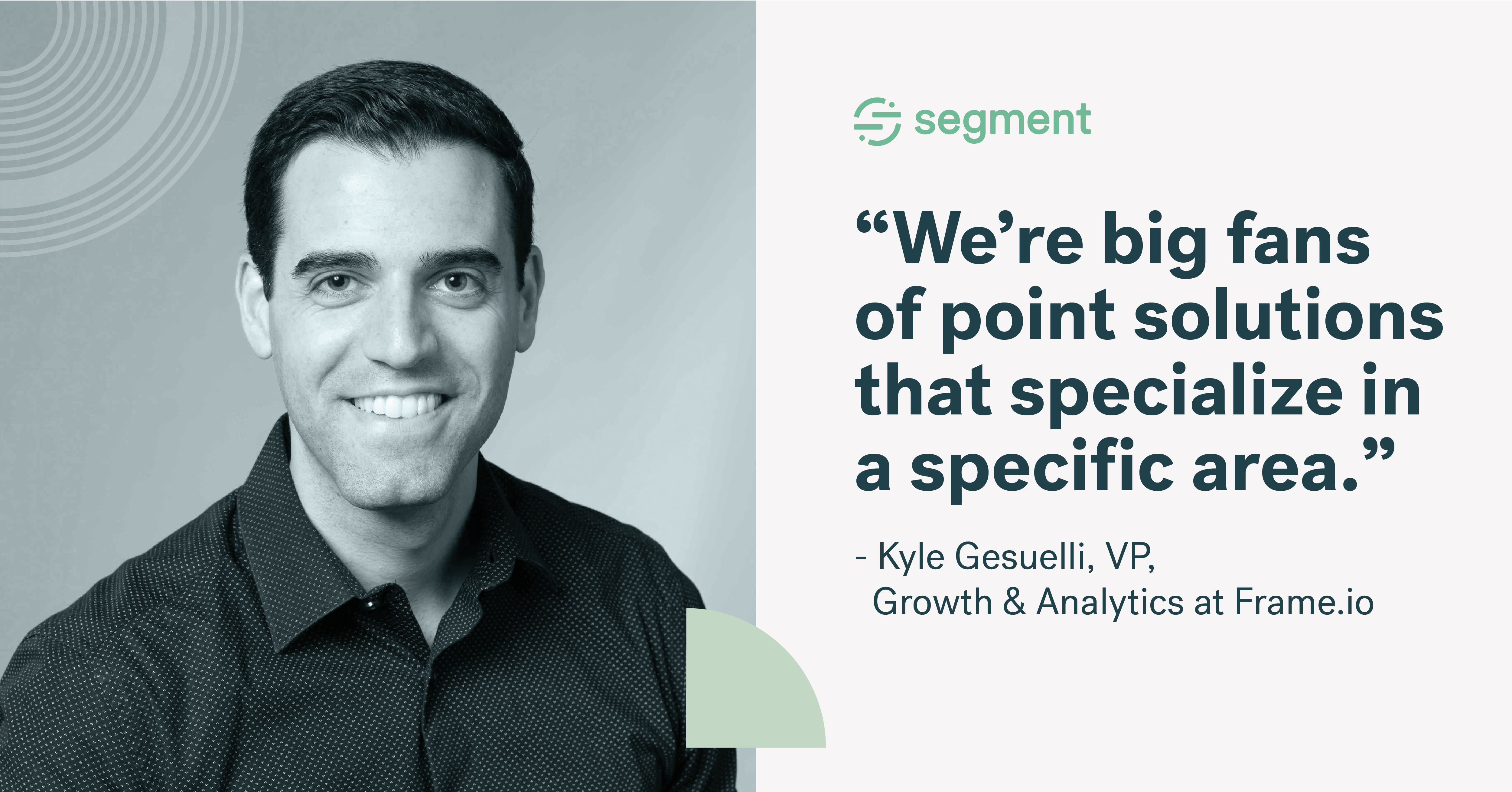
In general, we’re big fans of point solutions that specialize in a specific area. For example, the impetus for Appcues was that we had spent four months building our homegrown product tour and realized we needed to be able to quickly iterate without lots of hardcore development work. That’s just not a good use of our time.
And so we'll look for that point solution, but in discovering the point solution and trying to bring it on board, we’ll say “Oh, maybe there's an opportunity for consolidation here”. It very much depends. We're now a five-year-old company, with over 100 pieces of software used across the entire business. Segment is connected to 20 plus alone.
Stack changes are correlated with specialization
Geoffrey: Wow, so it sounds like you’ve moved from a tech stack of just a few tools to one of hundreds. I’m interested in whether there were key inflection points that caused you to adopt new tools? Product launches, new hires?
Kyle: I think scale and specialization allows for more advanced tools to be introduced. When a company is small, with limited resources, they'll typically purchase more user-friendly, approachable tools that the product team can get into and understand easily (Intercom, Mailchimp, Amplitude, etc.). As the company scales and gets more sophisticated, more complex and powerful tools are introduced (Salesforce Marketing Cloud, AutoPilot, Looker).
For example, we recently moved off Amplitude. It was an incredible tool for lightweight analytics, where you didn't manipulate the underlying data. It was simple and out of the box – perfect for smaller companies. But when you start to build up more and more tracking in your platform, you really need the ability to manipulate the underlying data, so we replaced Amplitude with Looker two years ago.
So there's a variety of reasons why a tool needs to change, but ultimately it boils down to three.
-
You’ve scaled past it in terms of many users it can hold in a functioning way, and it can't handle the volume of data and usage that you're throwing at it.
-
You've moved past it from a sophistication level. It was simple enough back in the day, but now that you have just more nuance, more complexity, you need something that can handle that complexity.
-
You're starting to focus on new areas, and your existing tools only do so much.

The final thing I’ll add is that you have to find tools that help you pull those all together. Fortunately, Segment is an incredible pipeline for us as well as a core analytics and tracking tool. Over the years, as we’ve brought on more and more tools, we bring a lot of data from these other sources into our warehouse via Segment.
So Intercom is sending us conversation data back into our warehouse via Segment. Stripe, the same thing. Salesforce, the same thing. Segment is the connective tissue of our tech stack.
How Frame.io invest and experiment with new technology
Geoffrey: Are there any key criteria you look at when you’re evaluating a new technology? Is it cost, interoperability, scalability, all of the above?
Kyle: First and foremost, we ask ourselves: “What would it take for us to build this?”.
At the scale of the company is at right now – we're 115 people – it usually doesn't make sense to devote our resources to building our own solution or hiring a new engineer to build it. I'd rather buy a tool that doesn't need a one-on-one every week than hire a person that does.
I have 10 direct reports, and can’t add more. So first and foremost, I need a tool that can do the job of a human, but that doesn’t require the same level of oversight.
The second is cost. Is the cost of that tool not outlandish? There's a level at which you care about price and a level that you don’t, which you don’t. If a tool is in the < $20,000 a year range, cost doesn’t really too much in our decision making. It’s when you get to $20-50,000 a year, you start putting this tool in the context of your existing stack, and wondering whether it can become a consolidation or replacement for other tools.
Then if you're talking >$80,000 a year, you have to do your due diligence and consider what the alternatives are and what the real value you’re getting out of it is.
But often you're moving so fast that you just need to get the thing done. By spending more of your team's time evaluating the tools, you're wasting more resources than just buying the tool.
Geoffrey: What are some of the new technologies you’ve experimented with recently and have found most valuable?
Kyle: Well, the good thing is, between Segment and Zapier, almost anything is possible, especially for someone who doesn't write Python.
But beyond that, I like to experiment with technologies and use cases that I can't do. So that could be adopting a new customer interface that I can't recreate without an engineer, like Appcues. Or it's a technology that I can't recreate. One of the things we're really hot on right now is Clearbit X because they have some crazy matching technology in their backend that gets me a 50% match rate on B2B email addresses in my social tools.
I just can't do that. That is a unique capability of the five years of work Clearbit put into that company. I'm not going to be able to recreate it.
So I would say my unique superpower is understanding how to take data from different contexts and using software to stitch it together to create an experience for a user.

Looking ahead to 2020
Geoffrey: As we wrap up 2019 and look ahead to the new year, what new technologies are you eyeing for the future?
Kyle: Right now we're looking for a better data pipeline. We're collecting so much data from Segment, that we need a tool that ensures accessibility and real-time data for all parts of our customer communications, as well as in our analytics.
The second is that we are shifting heavily to becoming enterprise-grade software. With that comes a need for account-based marketing, prospecting, and coordination of relationships with companies to sales team members that own those relationships.
This means making sure there are named accounts in Salesforce, which is connected to Drift, which is connected to Segment Personas. This ensures we have a 360-degree view of the named accounts we're going after and all the accounts that we have in the opportunity stage to sell to.
What’s most exciting is that we have found tools that go beyond the company. Instead of account-based marketing, it's actually person based marketing at those accounts. So we use a tool called Influ2, which does person-based marketing. Monitor and control who sees and clicks your ads, by name, which helps us be super focused on enterprise decision-makers. So if I'm targeting somebody from Target, my ad can be to that specific person at Target and the creative will include something about Target.
Then I'm getting data back into Salesforce or in back into my database about when that company hit, or when that person saw 5, 10, 50 impressions or when they clicked one, two or three times. Then I'm connecting that Outreach.io sequences. So once I get enough impressions or engagement, I'm then starting a drip-email campaign, then I'm changing the onsite experiences based on all the impressions that we've gotten from that company and the likes. So rather than going for a broad solution, we're rolling our own, based on a bunch of different tools.

The State of Personalization 2023
Our annual look at how attitudes, preferences, and experiences with personalization have evolved over the past year.